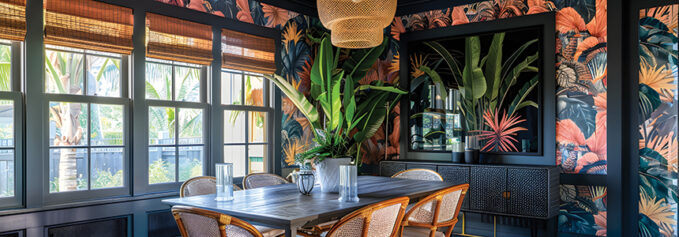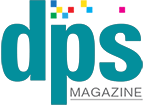
by Melissa Donovan
Digitally printed wallcoverings can take a space from simple to elevated elegance, and it isn’t just the graphic that achieves this, but the textures, embossments, and embellishments found in printable wallcovering materials.
As product design evolves for both wallcoverings and the printers/ink sets that can print to them, more options appear. These range from mimicking natural materials like wood or stone to complete custom collaborations with artists.
Above: Drytac’s ReTac Textures features an embossed canvas, sand, linen, or woodgrain-like finish that adds depth and visual appeal to static, flat graphics.
Early Beginnings
When digitally printed wallcoverings first came on the scene, texture was scarce. Vinyl as a smooth surface was paramount and other wallcovering materials mimicked their traditional cut-and-paste with glue predecessors.
“Wallcovering options began similarly to Henry Ford’s first cars, the Model T, and the famous saying—‘you can have it in any color, as long as it’s black.’ Early wallcovering options were limited in their variety of textures to smooth and canvas, similar to how Ford’s cars were limited in color options,” notes Jay Kroll, product manager for cut, transit, and wall solutions, General Formulations.
“Initially, most of the textures available in the digital printing market were the same as those found in traditional vinyl wallcoverings. These included classic textures that were popular at the time,” explains Angel Georgiou, senior product marketing specialist, Canon U.S.A., Inc.
Popular textures include canvas and pebble finish. “Textured materials for digital print were designed to emulate traditional wallpaper and fabric coverings. Early inkjet printers had difficultly getting quality colors on the more textured finishes,” shares Peter Bourgeois, territory manager, Drytac.
Kitt Jones, business management and co-creation manager, Roland DGA Corporation, admits that it was challenging to reproduce designs with clarity, color accuracy, and consistency at the advent of textured media digital printing.
“When digitally optimized wallcovering first hit the market, most of the available products were launched on smooth print surfaces because most of the providers came from the traditional side of the business where textures or finishes were done after print, rather than before. Furthermore, owing to the density of the paper or nonwoven, it can be difficult to capture and hold a grain or texture on such surfaces within the traditional production model,” notes Paul Paulette, director of market development, wide format, Potsdam Specialty Paper, Inc. (PSPI), which has a distribution relationship with Faze3 SMS.
Present Day
As technology advances and customer requests for variety increases, today’s digitally printed wallcoverings have evolved in terms of texture.
More options, like wood grain, exist, and Bourgeois points out that these textured wallcoverings are seen in commercial applications like lobbies, museums, and retail décor. “This is to create depth of image and enhance the feeling of an environment. A subtle texture draws attention to your image or message in a distinct and creative way.”
“Popular options now include grasscloth, linen, canvas, and plaster-like finishes, moving away from the more subtle, low-texture options like suede. These textures are commonly used in spaces where designers want to add a tactile, high-end feel while maintaining durability,” says Georgiou.
Now that “modern digital printers handle a wider variety of textured media, including more pronounced embossing, deeper textures mimicking natural materials like wood or stone, and even custom textures designed to complement specific artistic or design concepts,” the variety has expanded, suggests Jones.
“Embossments are growing more detailed and can offer different finishes or compatibility with printers to add different embossment effects right onto the media. These are used in commercial spaces, retail environments, immersive exhibitions, art installations, and trade shows,” says Audrianna Manee, marketing manager, Ultraflex Systems, Inc.
Kroll sees textured wallcoverings in all types of environments—from bedrooms to bathrooms and boardrooms. “Residential, retail, hospitality, commercial, and event spaces all benefit from the use of wall décor. It’s a profitable segment for any print service provider to be involved in.”
For those designers choosing texture, Paulette says it is to “add depth and character to their artist’s pallet, to allow light to play off the structured surface, and to help mitigate the impact of wall surface imperfections on the printed image.”
“We are consistently testing embossing patterns in our marketing department to see how inks interact with patterns ranging from leathers, fabrics, natural patterns, and industrial patterns as well,” shares a representative from Ecological Fibers, Inc.
The actual media isn’t the only thing producing texture, as aforementioned by Manee. “New UV inks and printers can print all sorts of raised textures on different textures, which is very interesting to see,” notes Jeff Mills, TexStyles national product manager, Beaver Paper & Graphic Media, Inc.
One example is Roland’s Dimensor S texture printer, which uses a structure ink, heat, and special PVC-free media to create customized textures and dimensional effects. “The unique interaction that takes place between the specialized PVC-free media, water-based CMYK inks, and structure ink as they run through the Dimensor S printer’s on-board heater allow these custom textures and embossing effects to be printed in one pass,” explains Jones.
Media Options
Textured wallcoverings are more common in vinyls, but as is true with any technology, advancements are paving the way for increased variety.
“Most textured wallcoverings are vinyl based due to their attributes. Vinyl wallcoverings have advantages in durability and cleanability, especially in high-traffic areas. Textures are available in both PVC-free and PVC-based wallcoverings, but currently there are more embossments available for vinyl materials as they are more popular,” explains Kylie Schleicher, director of product development, Ultraflex Systems.
According to Kroll, embossed patterns are primarily seen in vinyl substrates due to cost and “the inherent ability to mold and shape the vinyl to reflect the different textures. Paper and other materials are also used, but with less flexibility for specific patterned textures.”
With vinyl a top choice due to durability and versatility, Georgiou admits PVC-free products are making a push by offering textures similar to vinyl. However, they tend to be more subtle because of the inherent differences in the substrate.
“The majority of wallcovering media is PVC based,” agrees Bourgeois, “as it is very printable and has excellent longevity and can be easily cleaned. As is the trend in much of the industry, there is an increased demand for wallcovering to be more sustainably built and sourced driving increased paper-based and PVC-free materials.”
Polyester materials are gaining ground because they are not only sustainable, but non-flammable and the material does not shrink over time, according to Walter Gierlach, president, Photo Tex Group, Inc.
Jones believes that “textured wallcoverings aren’t restricted to any single material but depend on the specific manufacturing processes and design choices made by wallcovering producers. Each material brings its own benefits regarding texture appearance, durability, and maintenance characteristics.”
Good and Bad
Digitally printed wallcoverings featuring textures are an added aesthetic for any environment, however, there are challenges to be aware of in terms of printing.
Traditionally, “water-based and solvent ink sets did not have the lightfastness and permanence required for wallcovering applications without lamination, which was not an option on textures. Advances in latex and UV ink has made for far better results in colorfastness, wipeability, and cleaning,” shares Bourgeois.
Two issues to keep in mind are a textured wallcovering’s irregular surfaces and color consistency. “Textured wallcoverings often have irregular surfaces with varying heights and depths. Achieving consistent ink application across these textures can be challenging, leading to uneven print quality. Color consistency is also challenging, as achieving consistent color reproduction on textured wallcoverings can cause variations in ink absorption and surface reflectivity across different material parts,” shares Jones.
“One challenge with textured wallcoverings is that the texture itself can sometimes interfere with the pattern or image being printed. Matte finishes are often used to minimize this issue, but it’s crucial to ensure the texture complements the design being printed,” states Georgiou.
To ensure a proper finish—and that the ink adheres well—many vendors have their own secret sauce. Take Worthen Printable Fabric Solutions Group’s Fusion Digital Paper brand. “We make our own top coatings to assure ink/toner adhesion and print fidelity no matter how the print technology has developed over the years,” says Scott Cammons, sales manager, Worthen.
Another example, PSPI’s Digital Wallcover Portfolio is promoted as offering total cross platform ink compatibility. “While we have engineered our performance digital coatings to work equally well on both our Smooth as well as our textured surfaces, natural products like cork, string, handwoven jute, and wood remain a difficult cross platform challenge. Not only due to the differences in their surface energy, which relate to ink adhesion and durability, but also due to handling challenges on some of the printers. Not all media paths are created equally as some are more tortuous that others,” explains Paulette.
Ecological Fibers also enacts a proprietary coating process. These coatings include zero solvents, no heavy metals, or harmful chemicals. “The Brava PVC-Free Wallcoverings line can be coated with not only different finishes, but also create base colors, which in turn can reduce the expensive ink usage of the printers, sometimes by 80 percent,” explains the Ecological Fibers representative.
“It is important to choose a substrate that encompasses compatibility and can produce a top-quality product with a top coating that will provide no ink adhesion issues, as well as picking a product that print manufacturers trust,” attests Manee.
Trending into 2025
Whether it’s a specific texture or wallcoverings in general, there are big things to look forward to in 2025 and beyond.
Georgiou says high-end textures are popular and this popularity will continue into the new year. “The trend is moving toward more sophisticated and subtle textures that offer a high-end, refined look. Designers increasingly seek materials that not only deliver aesthetic appeal but also provide durability. As the demand for luxurious and elegant designs continues to grow we expect more interest in textures that offer a premium feel when printed.”
“The market really continues to grow in the home décor sector using well-known artists designing exclusive, new wallpaper images and patterns,” agrees Gierlach.
Jones also “sees continued exploration of wallcoverings as a medium for artistic expression, with collaborations between artists and manufacturers leading to more avant-garde designs.”
Speaking to adhesives, Bourgeois believes more temporary adhesives will be used so that wallcovering material can be cleanly removed without adhesive residue or damaging walls. “This trend is driven by the need for customizable, non-permanent solutions, especially with the rise of home office spaces and rental properly personalization.”
“I expect to see increasing demand for personalized and on demand designs that can be easily created and then printed on wallcoverings, allowing homeowners and designers to create unique spaces tailored to their preferences,” seconds Jones.
Sustainability is also of note. Schleicher foresees the focus on sustainability continuing to grow in this market as materials evolve and improve. Her colleague, Manee, says this is bolstered by increased environmental awareness, as well as consumers and designers focusing on reducing their carbon footprint. This is “even more so with laws or enforcements with building regulations such as ‘green’-certified buildings, eco-friendly hotels, and wellness facilities, in which sustainable textures will be found,” adds Manee.
“The next frontier for digital wallcovering may come from the evolution of durable structured woven fabrics at the upper end of the market, as we continue to push the envelope for unique as well as push past the traditional environmental challenges of a PVC-driven market,” adds Paulette.
Growing Together
The future of wallcoverings means keeping pace with all components of the print eco-system. “As paints evolve, and applications get more complicated, the materials will need to change and grow along with them. There is a push for more ‘one-size’ solutions and low-cost alternatives for sustainable materials and a broader portfolio of options, but at the core of that is the ability to confidently produce a quality product based on the customer’s requirements that helps to further their brand identity,” notes Kroll.
“Textures advance as the market changes and technologies advance. As the market asks for different traditional wallpapers and printers evolve, together the industry is able to change and grow available materials,” concludes Schleicher.
Textured wallcoverings is the theme of Digital Output’s November webinar @ digitaloutput.net/webinars
Jan2025, DPS Magazine



